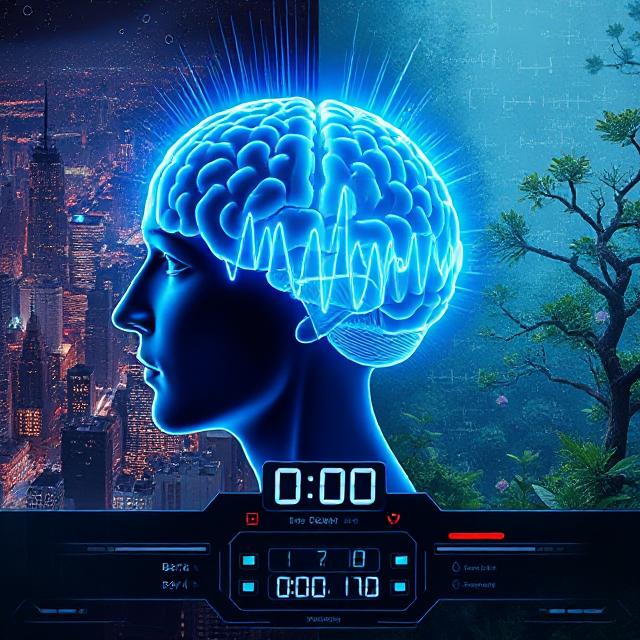
Table of Contents
Gamma Waves: Using Them for High-Level Insight
In the spectrum of brainwave frequencies, gamma waves occupy the highest range—often recorded at 30 to 100 Hz, and in rare cases, even higher. Long dismissed as “neural noise,” gamma rhythms are now emerging as key drivers of consciousness, memory binding, attention, and deep insight.
Unlike beta waves (linked to alert, logical thinking), or alpha waves (associated with calm relaxation), gamma waves represent integrative cognition—the moment when everything clicks. Whether you’re solving a complex problem, experiencing a sudden moment of clarity, or having a deep meditative realization, gamma is likely the brainwave behind it.
This article explores what gamma waves are, how they fuel high-level cognition, and how you can access gamma states to unlock learning, memory, and insight.
What Are Gamma Brainwaves?
Gamma brainwaves are the fastest known neural oscillations, occurring at a frequency of 30 Hz and above. They are often associated with:
- Peak cognitive function
- Holistic processing
- Sudden insights (“aha” moments)
- Memory encoding and retrieval
- Sensory integration
- States of heightened awareness
In EEG scans, gamma waves appear as tight, high-frequency bursts, often fleeting but powerful in their impact. They’re more commonly seen in:
- High-performing meditators
- Problem-solving professionals
- Polyglots and creative thinkers
- People in flow states
Neuroscience suggests gamma synchronizes activity across different regions of the brain, allowing diverse information to coalesce into a unified perception.
The Functions of Gamma Waves
1. Cognitive Integration
Gamma is the glue of cognition. When you:
- Read a paragraph and instantly “get it”
- Recall a complex memory with emotional color
- Connect abstract concepts across disciplines
…you’re experiencing gamma coherence.
Gamma waves allow your brain’s different regions—visual, auditory, emotional, linguistic—to operate in harmony, forming holistic understanding.
2. Learning and Memory
Gamma waves are heavily involved in working memory and long-term recall. They help:
- Bind disparate sensory inputs into a single experience
- Facilitate the consolidation of short-term memories
- Reactivate stored knowledge during focused thinking
When combined with theta rhythms (e.g., in REM sleep or deep focus), gamma bursts are thought to “stamp” key patterns into memory.
3. Neuroplasticity
Research suggests that gamma frequencies promote brain plasticity by:
- Strengthening synaptic connections
- Encouraging BDNF (Brain-Derived Neurotrophic Factor) release
- Enhancing inter-hemispheric communication
This makes gamma crucial in learning new skills, forming associations, and even recovering from brain injury.
Gamma in Meditation and Spiritual Practice
Studies on Tibetan monks and seasoned meditators show unusually strong and sustained gamma activity during:
- Compassion meditation
- Non-dual awareness
- Deep Samadhi states
In these moments, meditators report:
- Timelessness
- Panoramic awareness
- Intuitive understanding
- Effortless attention
🧪 In a famous study by Dr. Richard Davidson, meditating monks showed gamma activity 25 times greater than average subjects. This wasn’t a spike—it was a sustained trait.
This suggests that gamma is trainable—not just a genetic gift.
Gamma vs Other Brainwaves
| Wave | Frequency | Associated States |
|---|---|---|
| Delta | 0.5–4 Hz | Deep sleep, unconsciousness |
| Theta | 4–8 Hz | Imagination, dreaming, memory |
| Alpha | 8–13 Hz | Calm awareness, daydreaming |
| Beta | 13–30 Hz | Logical thinking, alertness |
| Gamma | 30–100+ Hz | Insight, synthesis, superlearning |
Unlike the others, gamma is always task-dependent. It arises when needed, especially during:
- Creative breakthroughs
- Pattern recognition
- Deep learning synthesis
- Spiritual insight
⚡ Real-World Benefits of Gamma Activation
1. Improved Focus & Attention
Gamma helps you stay locked in. When active, you can:
- Read complex material with clarity
- Solve multi-step problems more fluidly
- Sustain mental effort without fragmentation
2. Better Memory
Whether you’re encoding names, facts, or concepts, gamma increases:
- Information density
- Emotional “stickiness”
- Long-term recall
Gamma also helps contextualize memory—binding it to meaning and purpose.
3. Creative Synthesis
Have you ever combined two unrelated ideas into a novel solution? That’s gamma-driven creativity. It fuels:
- Abstract insight
- Poetic thought
- Multidisciplinary breakthroughs
4. Emotional Intelligence
Gamma connects emotional and cognitive regions of the brain. This allows:
- Empathic understanding
- Emotional context in reasoning
- Subtle social insight
Gamma helps you feel truth, not just understand it intellectually.
How to Access Gamma Brain States
Unlike alpha or theta states, which can be accessed through basic relaxation or music, gamma requires intensity and focus. But with the right conditions, anyone can cultivate it.
1. Focused Attention Practice
Pick a topic or puzzle that challenges your mind. Go deep. Examples:
- Solving a math problem by hand
- Reading dense philosophy
- Practicing a foreign language out loud
- Synthesizing conflicting sources in study
This engages top-down processing, known to trigger gamma bursts.
2. Meditation (Specifically Non-Dual or Compassion)
Mindfulness is good—but non-dual awareness (where the observer and observed dissolve) trains gamma most.
Practice:
- Tonglen or loving-kindness (metta) meditations
- Zen “just sitting” (shikantaza)
- Dzogchen or Mahamudra from Tibetan traditions
Even 15 minutes daily can change your gamma baseline over time.
3. High-Frequency Binaural Beats
While most brainwave entrainment targets alpha or theta, some tracks use 40 Hz gamma stimulation, especially paired with focused tasks.
Look for:
- “40 Hz Gamma” + “Study Music”
- Isochronic tones in the gamma range
- Stimulation paired with binaural beat coherence
4. Learning by Synthesis
Syntopic learning is an ideal gamma exercise. When you:
- Compare contrasting viewpoints
- Build visual mindmaps
- Create new frameworks from raw knowledge
…you’re not just studying—you’re structuring cognition itself.
Gamma is the wave of meaning. The more you think in connections, the more you live in gamma.
Scientific Studies Supporting Gamma Power
- Harvard Medical School (2004): Found 40 Hz gamma waves correlate with improved memory and perception.
- MIT (2016): Gamma frequency stimulation in mice reduced Alzheimer’s-related plaques.
- UC Berkeley (2019): Gamma entrainment helped older adults boost short-term memory scores.
- Davidson & Lutz (2004): Tibetan monks showed sustained gamma activity during compassion meditation—linked to happiness, attention, and emotional clarity.
Cautions About Overstimulating Gamma
While gamma is generally beneficial, too much forced stimulation (e.g. overuse of 40 Hz beats or nootropics) may lead to:
- Mental fatigue
- Insomnia
- Anxiety or overstimulation
Balance gamma cultivation with recovery states like alpha or theta. Think of gamma as the apex—not the base—of your cognitive pyramid.
Final Thoughts: Gamma as the Gateway to Insight
Gamma waves represent the integrative intelligence of the human brain. Where delta is the ground and theta is the dream, gamma is the flash of light that brings everything together.
Want to remember more?
Learn better?
Feel insight rather than chase it?
Then start building your life around depth, synthesis, and focused presence. Gamma will follow.






